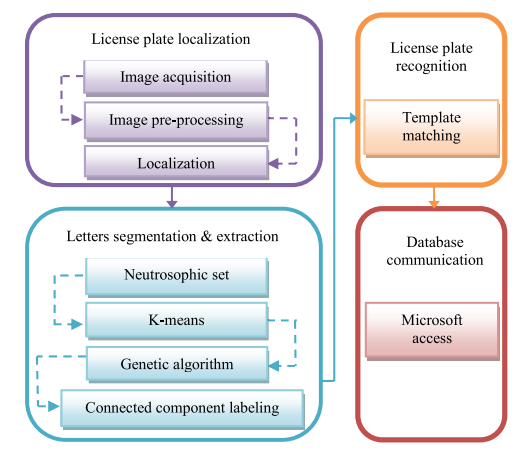- ALL COMPUTER, ELECTRONICS AND MECHANICAL COURSES AVAILABLE…. PROJECT GUIDANCE SINCE 2004. FOR FURTHER DETAILS CALL 9443117328


Projects > ELECTRONICS > 2020 > IEEE > DIGITAL IMAGE PROCESSING
The present paper proposes a new methodology for license plate (LP) recognition in the state of the art of image processing algorithms and an optimized neutrosophic set (NS) based on genetic algorithm (GA). First of all, we have performed some image processing techniques such as edge detection and morphological operations in order to utilize the (LP) localization. In addition, we have extracted the most salient features by implementing a new methodology using (GA) for optimizing the (NS) operations. The use of (NS) decreases the indeterminacy on the (LP) images. Moreover, k-means clustering algorithm has been applied to segment the (LP) characters. Finally, we have applied connected components labeling analysis (CCLA) algorithm for identifying the connected pixel regions and grouping the appropriate pixels into components to extract each character effectively. Several performance indices have been calculated in order to measure the system efficiency such as accuracy, sensitivity, specificity, dice, and jaccard coefficients. Moreover, we have created a database for all detected and recognized (LP) for testing purposes. Experimental results show that the proposed methodology has the ability to be suitable for both (Arabic –Egyptian) and English (LP). The proposed system achieves high degree of recognition accuracy for the whole system according to the following case studies; (i) for a high resolution Egyptian (LP), the proposed system achieves about 96.67% accuracy of correct recognition, (ii) for a low resolution-corrupted English (LP), the proposed system achieves about 94.27% accuracy. In addition, we have applied the proposed system on some sort of image disturbance i.e. (flash in image, external noise, and illumination variation), the proposed system achieves about 92.5% accuracy of correct identification. However, traditional methods achieve about 79% accuracy of correct identification in the presence of such image degradations. This reflects how the proposed system is generalized, optimized, and proposes high degree of recognition accuracy.
Optical character recognition (OCR) with templates matching, and correlation approach for plate recognition
We have proposed a new methodology for license plate recognition (LPR) in the state of the art of image processing algorithms and an optimized neutrosophic set (NS) based on genetic algorithm (GA). We have Extracted the most salient features by implementing a new strategy according (GA) for optimizing the (NS) operations. The use of (NS) set decreases the indeterminacy on the license plate (LP) images. We have applied k-means clustering algorithm to segment the (LP) characters. We have applied connected components labeling analysis (CCLA) algorithm for identifying the connected pixel regions and grouping the appropriate pixels into components to extract each character effectively. The proposed system has targeted a high rate of recognition accuracy in the presence of (LP) image degradations and disruption.
BLOCK DIAGRAM
